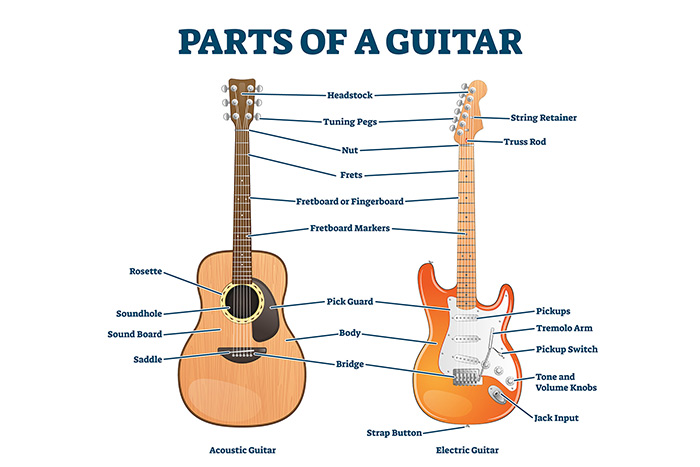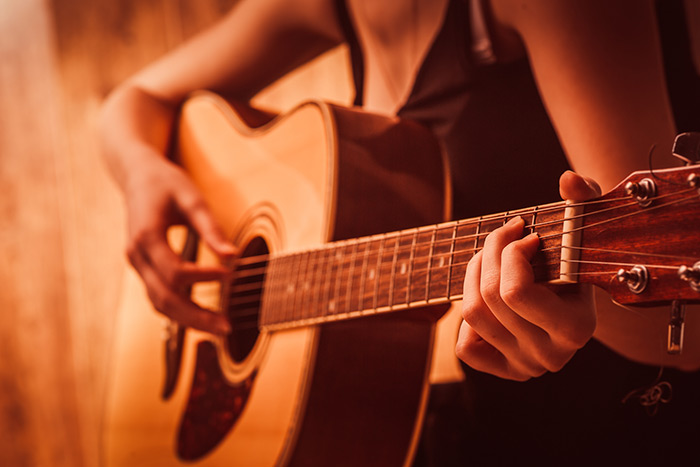What Are Triads?
So before we start jumping into playing triads across the guitar neck, let’s have a recap of what triads are to start with. The triad is the simplest form of a chord that we have in music, comprised of three notes stacked on top of each other, hence the name. The triad comes from the major or natural minor scale, and is formed when you play the 1st, 3rd and 5th degrees together at the same time. These three notes can go on to form the core of many other different types of chords.
Whether you know it or not, you have most likely been playing triads on the guitar without even knowing it! Anytime you are playing simple open chords such as Am, G, C, D, Em, these are all triads. If you were to go through and analyse each note of the chord relative to its parent scale, there are only the 1st, 3rd and 5th degrees in each chord, although for our open chords on the guitar we will be doubling up on some notes. For example, in a C major open chord we have the 1st (C), 3rd (E), 5th (G), 1st (C), 3rd (E). They don’t necessarily have to be in order either. When we are playing barre chords, we are also playing triads! For a simple A major barre chord played on the 5th fret of the low E string, we are playing the 1st (A), 5th (E), 1st (A), 3rd (C#), 5th (E), 1st (A).
Major Triad Shapes
It is very useful for us to learn some simple triad shapes across the neck, meaning for one chord we can play this in multiple locations. We usually do this in different ‘string-sets’, which is basically just different groups of strings. For now, let’s look at G major triads across the neck on the G B E string-set and the D G B string-set.
For these shapes we won’t be doubling up on any notes to keep things simple. Try playing these three different triad shapes for our G B E string-set. This will place the same triad in three different places on the neck. Even though we will have a different order of notes, we will still be playing a G major triad, but in different inversions. Our first shape that we have would be what’s called a first inversion (3 – 5 – 1), our second shape is a second inversion (5 – 1 – 3) and our final shape is a root position triad (1 – 3 – 5). Play through this a few times to memorise where these are found, then try them on different chords (e.g. C major, D major, A major ect.).
For our next group of triads we will still be looking at G major triads, but now on the D G B string set. Using different string-sets will be a great way for us to unlock different sounds in different registers of the guitar. We again have three different triad shapes in three different inversions, but this time we start with a root position triad, then first inversion, then second inversion. Try this first on G major, then over some other chords.
Minor Triad Shapes
Now it will be very important for us to think about the minor triads, as we will need these just as much as the major ones!
The way in which we form a minor triad is exactly the same as any other minor chord, by flattening the third of what would have been the major chord. This means that the formula for a minor triad is
1 – b3 – 5. We can take our existing major triads that we have already learnt above, and simply just flatten the third of these chord to convert them into G minor triads. This will also be a great exercise for thinking what degrees you have in which order in these chords. First have a play through the minor triads on the G B E string-set.
Once you feel ready, also have a go at this on the D G B string-set.
Other String-Sets
Once you feel comfortable with both the G B E string-set and D G B string-set, it will be important to move on to playing these triads on the A D G and E A D string-sets as well. These will open up some different sounds in the lower register of the guitar that will serve a different purpose to those in the higher register. This will also then unlock the entire guitar neck, leaving you with no grey areas on these triads! This will serve multiple purposes for you once you have done this ground work.
How Can We Use This?
So it’s great that we’ve gone and learnt these shapes and everything, but how are we actually supposed to use them now? Whether you realise it or not at this stage, triads are the foundation for a lot of music, both in harmony and single note melody playing. Even if we aren’t playing one of these particular triad shapes or even playing a chord at all, we are often playing a group of single notes that are based on a triad, since this will help our melody to fit within our chord changes. This means that we can play triads both in our chordal/rhythm playing, and in our lead playing.
For our chordal playing, we can start to use these over a simple I IV V progression (as this will be another basis for many songs), and work on changing our triad shapes around these different chords in time with a song. This will give us many options of where to voice these on the guitar neck, depending on if we want to use higher or lower sounds.
We can also add triads into our lead playing quite easily. Again if we are playing over a I IV V progression, we can blanket the one scale of the key over some of this, but then also add in our triads off of each chord to outline these chord changes. For example, if we are playing I IV V in the key of C (C, F, G), we can play just the C major/A minor pentatonic scale over some of this, but then outline the F and G triads when we land on these chords by arpeggiating some of the triad shapes. When you do this you should always aim to land back on a strong note of the key to resolve this change.











